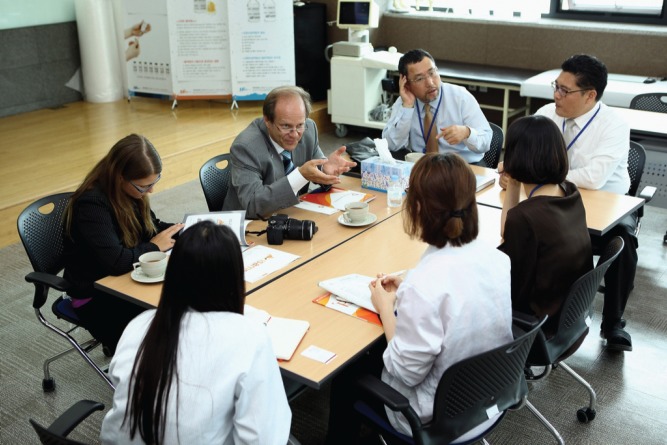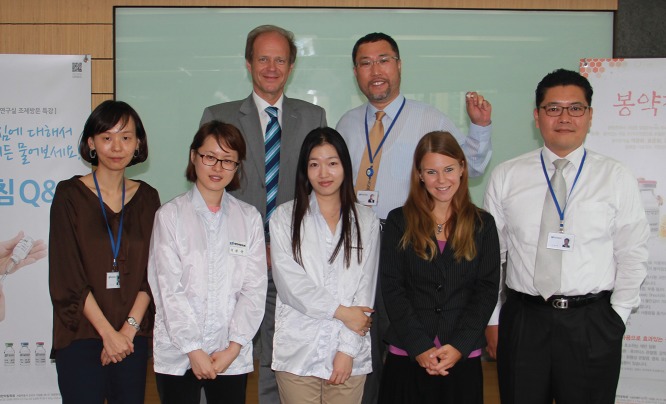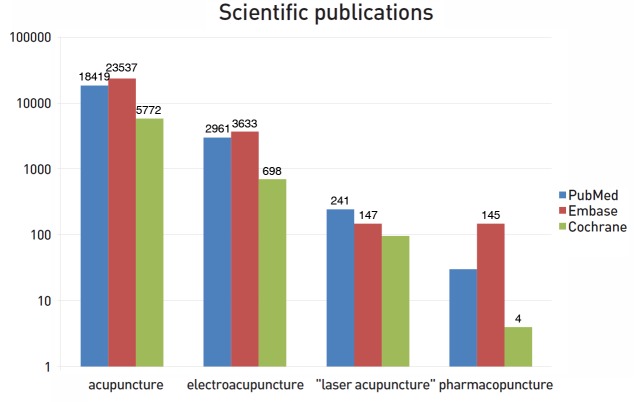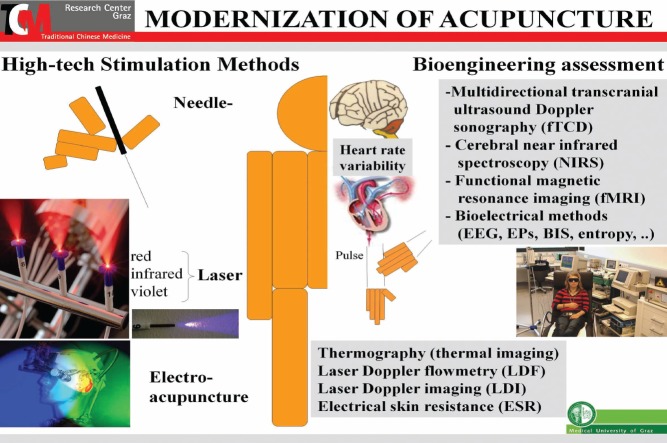Abstract
Objective:
Pharmacopuncture, a new therapy in traditional medicine, has attracted significant attention since its introduction to the Western world. This short review article employs a database analysis to examine the profile of publication activity related to pharmacopuncture.
Methods:
Three databases were searched: PubMed, Embase, and Cochrane. About 300 papers related to the topic "pharmacopuncture" were found in these three most-commonly-used databases.
Results:
Fourteen papers are described in detail and are discussed in the context of the research performed at the Medical University of Graz, especially by the Frank Bahr Research Group "Auriculomedicine and Pharmacopuncture."
Conclusion:
High-tech research methods concerning future pharmacopuncture studies are briefly discussed.
Keywords: acupuncture point injection, aqua acupuncture, herbal acupuncture, high-tech acupuncture, pharmacopuncture, point injection
1. Introduction
The absence of scientific development processes in basic and clinical research on the topic of pharmacopuncture has held back the integration of Korean pharmacopuncture into medical systems in Europe for many years. The concepts of the method appear practical, but without basic and clinical research and objective measurements of pharmacopuncture effects, limits on rapid development still exist in Europe. However, these obstacles to rapid growth are slowly getting fewer. The concepts of Korean pharmacopuncture therapies might sound very different and strange to Western people, but some initial approaches fit scientific investigations on the topic.
The use of a natural herbal substance in combination with acupuncture as a new needle therapy has the potential to treat many diseases. The therapy has been promoted in Asia, especially in Korea, for some decades. However, to date, very few systematic assessments of the evidence to support the effectiveness of this form of acupuncture exist in Europe.
This article serves as the first general systematic European review evaluating pharmacopuncture as primary intervention and is based on a visit of the Austrian authors to the Korean Pharmacopuncture Institute (KPI) in Seoul on September 14, 2012 (Figs 1, 2) In this context, the authors would like to express their gratitude for the great hospitality shown by everyone on the Korean Pharmacopuncture team.
Fig. 1. Discussion and introduction of Korean pharmacopuncture and Austrian high-tech acupuncture in September 2012 in Seoul.
Fig. 2. Warm welcome from the Korean Pharmacopuncture Institute (KPI) for the Austrian authors of this article on Sept. 14, 2012.
2. Current scientific pharmacopuncture research
A search of three scientific databases, PubMed, Embase, and Cochrane Library, on Dec 6, 2012, yielded more than 300 publications related to pharmacopuncture. The search terms were "pharmacopuncture," "acupoint injection,""herbal acupuncture," "aqua acupuncture," "acupuncture point injection," and "point injection" (see Figs 3, 4) Fourteen referenced publications with the term "pharmacopuncture" in the title [1 - 14] are described in detail and cited in the list of references. Compared to acupuncture in general and electroacupuncture (see Fig. 3), this number of publications is very small; however, it is in the range of the number of publications of laser acupuncture. In the following, the 14 publications from the three databases will be discussed in detail.
Fig. 3. Pharmacopuncture and three different scientific databases available in Europe.
Fig. 4. Search terms related to pharmacopuncture in the three different scientific databases available in Europe.
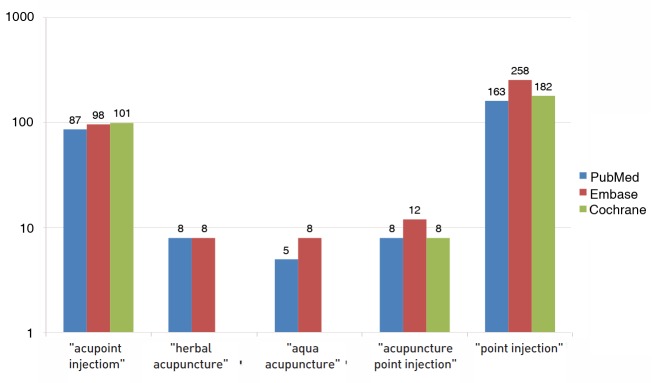
The first three papers on the topic "pharmacopuncture" available in Europe are in Russian [1 - 3]. In 1997, Vasilenko et al. [1] published a manuscript concerning pharmacopuncture and neuroimmunomodulation. The paper by Belitskaia et al. from 1999 [2] deals with the effects of pharmacopuncture on blood chemistry, e.g., the concentrations of serotonin, beta-endorphine, myoglobin, and basic myelin protein. Patients with tunnel hand syndrome were investigated. A specificity of acupuncture stimulation by introducing of fluid was found, but no specificity was found for different drug effects [2]. In the paper by Sukhareva et al. [3], 120 children (aged between 4 and 15 yr) with neurosensory hypoacusis who underwent pharmacopuncture treatment were investigated. The drugs cerebrolysin, cavinton, and prozerin were injected (dose: 0.1 ml) at biological active acupuncture points. A clinical improvement was confirmed in the majority of the children [3].
The first paper in English available in PubMed was published in the journal Evidence-based Complementary and Alternative Medicine [4]. That paper contained a detailed description of animal experimental investigations and compared the use of pharmacopuncture, aquapuncture, and acepromazine for sedation of horses.
Eight animals were investigated randomly. Heart rate, respiratory rate, head height and degree of sedation were measured at different time intervals. Only the pharmacopuncture group showed significantly lower values of head height after sedation. Pharmacopuncture using acepromazine at the acupuncture point GV1 produced a mild sedation when compared with the conventional dose [4]. In the same year, another author from Russia, Agasarov [5], investigated the mechanism of pharmacopuncture based on clinical data on low back pain. The author observed a reduction of vaso-reflectory reactions.
An interesting study was published in the Journal of Acupuncture and Meridian Studies in 2009 by Korean researchers [6]. Yook et al. compared the effects of distilled Rehmannia glutinosa, wild ginseng and Astragali Radix pharmacopuncture on the autonomic nervous system. Especially the heart rate variability (HRV) was used as a parameter in this investigation. Three experimental groups and a control group (altogether 120 healthy male volunteers) were compared in a randomized, placebocontrolled, double-blind clinical trial. The result was that verum pharmacopuncture tended to activate the autonomic nervous system, particularly the sympathetic nervous system [6]. In this context, we should mention that the investigation of the HRV is also a main focus of research at the TCM Research Center in Graz in Austria (see Fig 5) Apart from this measurement parameter, (Fig 5) shows several acupuncture stimulation methods, as well as methods for bioengineering assessment of the effects of acupuncture available at the Medical University of Graz.
Fig. 5. Spectrum of methods for high-tech acupuncture research at the Medical University of Graz (modified from [15]).
Another indication for pharmacopuncture is knee osteoarthritis [7]. This medical condition was investigated at Dongguk University in Seoul. Two groups, each with 30 patients, were compared. The experimental group received pharmacopuncture using root bark of Ulmus Davidiana Planch twice a week for six weeks; the control group received normal saline injections. The authors found that pharmacopuncture was more effective in pain reduction; however, the interventions were not significantly different. No subject showed adverse effects [7]. In the same journal, Kim and Kang [8] reviewed trends in research related to Korean pharmacopuncture therapy. This literature review was based on articles published from 1997 to 2008 in the Korean Pharmacopuncture Journal. During that period, 164 papers dealt with pharmacopuncture research and were thus included in the review. The most frequently studied pharmacopuncture materials found in this review are listed in (Fig 6) The bladder meridian and the acupuncture point ST36 (Zusanli) were the most used meridian and acupoint, respectively [8].
Fig. 6. The most-commonly-used pharmacopuncture materials [8].
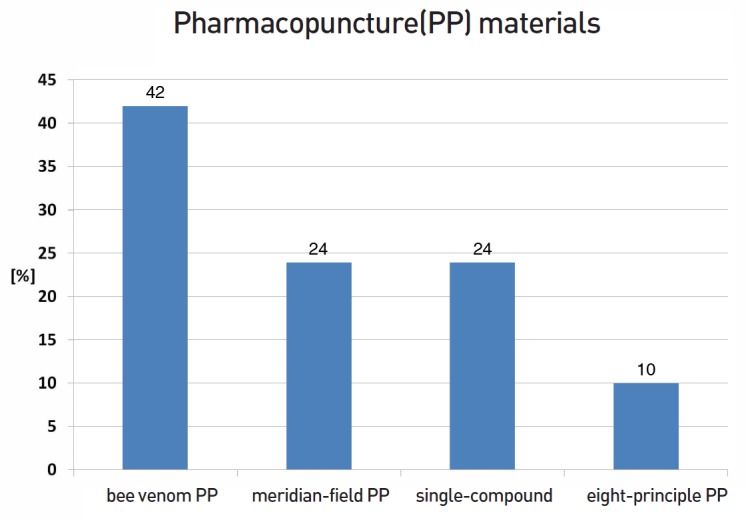
In principle, pharmacopuncture is a safe method, provided the herbal substances are produced using standard sterile processes. This is also reflected in the literature available in Europe. However, there are reports about side effects [9] when the pharmacopuncture material is not produced under sterile conditions. The case report by Koo et al. describes multiple abscesses in the psoas region with fever and pain after pharmacopuncture [9].
Another systematic review and meta-analysis article was published recently in the renowned journal Evidence-based Complementary and Alternative Medicine [10]. Shen et al. searched eight electronic databases and six journals for randomized clinical trials in which patients with asthma received pharmacopuncture treatment. Their meta-analysis showed statistically significant effects of pharmacopuncture compared to conventional treatment.
Two more papers on the topic of pharmacopuncture were published within the last two years in the Journal of Acupuncture and Meridian Studies [11, 12]. Kwon et al. [11] observed the efficacy of mountain Ginseng pharmacopuncture on cancer patients treated using different methods of acupoint injection and intravenous infusion. Six patients were investigated. The authors concluded that intravenous infusion of pharmacopuncture material is more effective than acupoint injection. Kim et al. [12] investigated 29 patients with urinary incontinence. After a single treatment with the traditional Korean medical therapy, patients showed improved pelvic muscle contraction ability.
Two more related papers [13, 14] were published within three months of each other. The first study, published in June 2012 and performed at Daejeon University in Korea, deals with the safety of sweet bee venom pharmacopuncture for chemotherapy-induced peripheral neuropathy [13]. No adverse side effects of this method were found in the four patients who completed all treatment sessions. Within the second study from August 2012 [14], a total of 11 patients were treated in six sessions of sweet bee venom pharmacopuncture, each within a 3-week period. All measured scores showed improved neuropathy level and improved quality of life.
3. Conclusion
At first sight, Korean pharmacopuncture seems to have nothing to do with high-tech acupuncture. The central task of high-tech acupuncture is to scientifically demystify acupuncture by using biomedical high-tech equipment. High-technology tools are used as stimulation methods and as methods for recording the effects of acupuncture. However, if one takes a closer look, one can clearly see that the same spectrum of methods used at the Medical University of Graz (Fig 5) can be used for investigations of needle, laser, and electroacupuncture, as well as for the assessment of Korean pharmacopuncture. HRV, mentioned in the discussion of the papers above, is only one major area of research at Graz
Here, we should mention that Austria has also some tradition in research on Oriental and Integrative Medicine. For more than 15 yr, research concerning high-tech acupuncture has been playing an important role at the Medical University at Graz. Over the last few years, a hightech acupuncture network was built with many important partners from Asia. In the future, this network, which currently includes research on needle, laser, and electroacupuncture [15 - 17], will be expanded. We also believe that pharmacopuncture should be included among the interesting topics of research.
Acknowledgments
This publication was supported by the Stronach Medical Group and the German Academy for Acupuncture (DAA). The authors thank Ingrid Gaischek, MSc, from the Medical University of Graz for her valuable help in manuscript preparation. The authors declare their having no conflict of interest.
References
- 1.Vasilenko AM, Kozodaev VO, Orlov SM, Arion VY. Pharmacopuncture neuroimmunomodulation as a new approach to prevention and treatment of secondary immunodeficiencies. Immunology. 1997;(3):52–55. [Google Scholar]
- 2.Belitskaia RA, Vasilenko GF, Krasnova LB, Popkova EV, Chuzavkova EA, Agasarov LG. [The effect of pharmacopuncture on the blood biochemical indices of patients with tunnel syndromes of the hands] Vopr Kurortol Fizioter Lech Fiz Kult. 1999;(5):14–17. Russian. [PubMed] [Google Scholar]
- 3.Sukhareva MP, Aref'eva NA, Farkhutdinova LV. [Pharmacopuncture in combined treatment of children with neurosensory hypoacusis] Vestn Otorinolaringol. 2000;(6):24–26. Russian. [PubMed] [Google Scholar]
- 4.Luna SP, Angeli AL, Ferreira CL, Lettry V, Scognamillo- Szabo., M Comparison of pharmacopuncture, aquapuncture and acepromazine for sedation of horses. Evid Based Complement Alternat Med. 2008;5(3):267–272. doi: 10.1093/ecam/nel096. [DOI] [PMC free article] [PubMed] [Google Scholar]
- 5.Agasarov LG. Pharmacopuncture in dorsopathy treatment. J Acupunct Meridian Stud. 2008;1(2):110–113. doi: 10.1016/S2005-2901(09)60030-3. [DOI] [PubMed] [Google Scholar]
- 6.Yook T, Yu J, Lee H, Song B, Kim L, Roh J et al. Comparing the effects of distilled Rehmannia glutinosa, Wild Ginseng and Astragali Radix pharmacopuncture with heart rate variability (HRV): a randomized, shamcontrolled and double-blind clinical trial. J Acupunct M eridian Stud. 2009;2(3):239–247. doi: 10.1016/S2005-2901(09)60061-3. [DOI] [PubMed] [Google Scholar]
- 7.Kim EJ, Jang MK, Yoon EH, Jung CY, Nam DW, Lee SD et al. Efficacy of pharmacopuncture using root bark of Ulmus davidiana Planch in patients with knee osteoarthritis: a double-blind randomized controlled trial. J Acupunct Meridian Stud. 2010;3(1):16–23. doi: 10.1016/S2005-2901(10)60003-9. [DOI] [PubMed] [Google Scholar]
- 8.Kim J, Kang DI. A descriptive statistical approach to the Korean pharmacopuncture therapy. J Acupunct Meridian Stud. 2010;3(3):141–149. doi: 10.1016/S2005-2901(10)60029-5. [DOI] [PubMed] [Google Scholar]
- 9.Koo EH, Choi SS, Chung DH, Lee IO, Kim NS, Lim SH. Multiple psoas abscess formation after pharmacopuncture -a case report. Korean J Pain. 2010;23(4):270–273. doi: 10.3344/kjp.2010.23.4.270. [DOI] [PMC free article] [PubMed] [Google Scholar]
- 10.Shen FY, Lee MS, Jung SK. Effectiveness of pharmacopuncture for asthma: a systematic review and metaanalysis. Evid Based Complement Alternat Med. 2011;2011 doi: 10.1155/2011/678176. [DOI] [PMC free article] [PubMed] [Google Scholar]
- 11.Kwon KR, Kim H, Kim JS, Yoo HS, Cho CK. Case series of non-small cell lung cancer treated with mountain Ginseng pharmacopuncture. J Acupunct Meridian Stud. 2011;4(1):61–68. doi: 10.1016/S2005-2901(11)60008-3. [DOI] [PubMed] [Google Scholar]
- 12.Kim YJ, Kim MC, Lee CH, Kim JU, Yook TH. The effect of needle-embedding therapy and pharmacopuncture therapy on patients with urinary incontinence. J Acupunct Meridian Stud. 2011;4(4):220–224. doi: 10.1016/j.jams.2011.10.012. [DOI] [PubMed] [Google Scholar]
- 13.Park JW, Jeon JH, Yoon J, Jung TY, Kwon KR, Cho CK et al. Effects of sweet bee venom pharmacopuncture treatment for chemotherapy-induced peripheral neuropathy: a case series. Integr Cancer Ther. 2012;11(2):166–171. doi: 10.1177/1534735411413265. [DOI] [PubMed] [Google Scholar]
- 14.Yoon J, Jeon JH, Lee YW, Cho CK, Kwon KR, Shin JE et al. Sweet bee venom pharmacopuncture for chemotherapy- induced peripheral neuropathy. J Acupunct Meridian Stud. 2012;5(4):156–165. doi: 10.1016/j.jams.2012.05.003. [DOI] [PubMed] [Google Scholar]
- 15.Litscher G. Modernization of traditional acupuncture using multimodal computer-based high-tech methods -recent results of blue laser and teleacupuncture from the Medical University of Graz. J Acupunct Meridian Stud. 2009;2(3):202–209. doi: 10.1016/S2005-2901(09)60056-X. [DOI] [PubMed] [Google Scholar]
- 16.Litscher G, Gao XY, Wang L, Zhu B, editors High-tech acupuncture and integrative laser medicine. Pabst Science Publishers; Germany: 2012. p. 189. [DOI] [PMC free article] [PubMed] [Google Scholar]
- 17.Litscher G, Schikora D, editors Laserneedle- Acupuncture. Pabst Science Publishers; Germany: 2005. p. 253. [Google Scholar]



